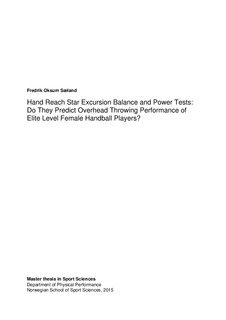| dc.description.abstract | Background: Throwing performance is an important factor for scoring goals in
handball. Mobility and power are two physical factors considered to be important for
producing high ball speed. Evidence in the literature for a relationship between mobility
tests and throwing performance, and power tests and throwing performance, are scarce
and variable. One explanation for the variable and poor relationship to throwing
performance could be that the conventional mobility and power tests are not specific
enough to throwing. Aim: The aim of this study was to investigate the influence of
mobility and power on overhead throwing with run-up, utilizing more sport specific
tests (HSEBT and 1080 Quantum). The hypotheses being that: 1) functional mobility
measured by the hand reach star excursion balance test (HSEBT) is significantly
correlated with throwing performance, and 2) maximum power measured by the 1080
Quantum is significantly correlated with throwing performance. Methods: Thirteen
elite female handball players were recruited for the study, with twelve completing the
testing protocol. A HSEBT, consisting of twelve hand reaches were used to measure
mobility. Power was measured by twelve tests, consisting of six hop, two push, two pull
and two rotational tests, using the 1080 Quantum. Throwing accuracy and ball speed
were used as the measures for throwing performance. Results: No significant
correlations was found between any HSEBT tests and throwing performance. For the
power tests, only left foot anterior to posterior hop significantly correlated with ball
speed (r = 0.577, p<0.05). Additionally, the non-dominant hand posterior and superior
diagonal pull (r = 0.601, p<0.1) and the right foot anterior hop (r = 0.538, p<0.1) were
correlated with a statistical tendency to throwing accuracy. Conclusions: The results of
this study suggest that neither the mobility nor the power tests can be used as individual
predictors of performance for overhead throws with run-up. The correlations found
between the power tests and throwing performance is likely due to coincidence, rather
than a statistically relevant relationship. However, the tests and idea of moving away
from conventional testing to a more sport specific approach should not be completely
discarded, since the study had a limited amount of subjects. Thus, more studies into the
use of sport specific mobility and power tests are recommended. | nb_NO |
